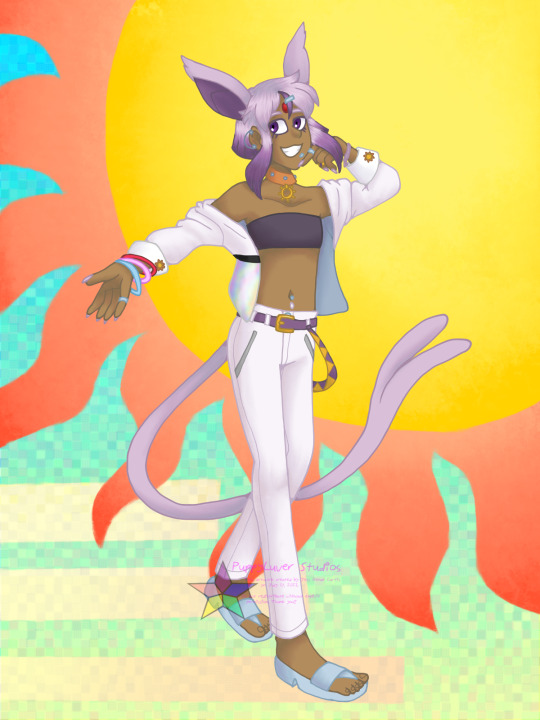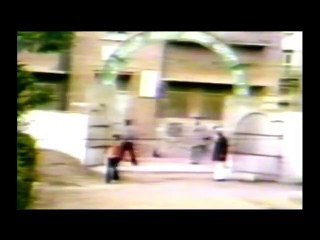#kiran laghari
Text

[Image Description: Kiran Laghari, an Espeon Pokejinka. They have medium-brown skin, short lilac and violet hair, violet eyes, a red oval jewel in the center of their forehead, large Espeon ears on their head, and a long Espeon tail. They are wearing various bits of jewelry and piercings, an orange collar with a gold sun-shaped ring attached, a purple tube top, a pale lilac jacket that is made partially of holographic material with sun-shaped cufflinks, lilac pants, a purple and gold belt, and light blue heeled sandals. They are holding out one hand, the other near their face as they smile. The background features a turquoise and yellow pixelated gradient, pale yellow and orange rectangles resembling steps positioned near Kiran's feet as though they are walking down them, and a large orange and yellow sun taking up most of the background from the top right corner. End ID.]
-----
More Art Fight with Kiran! It may not be my preferred method of doing Pokejinkas per se, but I can still appreciate the ones where people keep the ears and tail and such in the human design, especially when it makes their Look unique. And Kiran is gorgeous anyway! Absolute stunner :D
🎨 Good luck to all my fellow Art Fight participants! And most importantly, have fun!! 🎨
Espeon and other Pokemon concepts © Nintendo/GameFreak
Kiran Laghari © @ar-ameth
Artwork © PuppyLuver Studios
#art fight#art fight 2023#pokemon#pokejinka#espeon#kiran laghari#ar ameth#jess drew the thing#sfw#image description
7 notes
·
View notes
Text
Siah Kiran - Ek Haqeeqat Ek Fasana
Siah Kiran – Ek Haqeeqat Ek Fasana
https://www.dailymotion.com/video/x8czmeh
Siah Kiran – Ek Haqeeqat Ek Fasana
Written by: Riaz Batalvi / Saleem ChishtiProduced By: Qambar Ali Shah
Starring: Mustansar Hussain Tarar, Tahira Naqvi, Asif Raza Mir, Sarwat Atiq, Farzana Sidiqui, Nisar Qadri, Aurangzeb Laghari, Tanwer Rathor, Nabela, Nasreen, Latifi, Munawar Saeed,

View On WordPress
0 notes
Link
The golden leaves of Indus | Art & Culture | thenews.com.pk A group show, titled Golden Leaf of Indus, is on display at Art Chowk Gallery. The show has been curated by Akbar Ali who is an artist, art educator and researcher. Comprising 28 paintings by emerging artists, the exhibition covers several themes in different mediums. The works have been inspired by the artists’ personal experiences, observations, research and comments over social issues. The topics have resonated with the viewers, of whom many might have experienced similar emotions at some stage in their lives. Most of the works appear original and true to their billing. One of the art pieces is a ghungroo (ankle bell) hung using a thin invisible wire. Aqsa Bhutto has decorated it using silver thumb tacks. The flat heads of the pins are on the front and enhance its beauty. The sharp ends are towards the wearer. This could tell of the pain of the dancer wearing these. Another sculpture represents a uterus made in fibre-glass and painted in white. Whereas white signifies peace and harmony in Western art, it is associated with sadness and grief in Asian cultures. The artist is referring to the stigmatisation of women. The sculpture rests on one of the tables and speaks of inequality and worthlessness that a woman feels when she goes through pregnancy, menstruation or hormonal changes that her body experiences. Mudassar has put various wooden and metal objects together to form an image of a pigeon, a pot and a girl in a single frame. Taimoor Ali has painted individuals on tiles and labeled the works Poverty I and Poverty II. Rajab Charan’s Seeing the unseen shows a young lady sitting idle, gazing at a tiny bird. The participating artists include Afsah Ahmed, Alishba Khan, Anshara, Aqsa Bhutto, Areeba Nadeem, Ayesha Shaikh, Wania Shaikh and Tooba Shaikh from the SABS; Beenish, Irfan Channa, Marium Arshad and Beenish Khalid from the NCA, S Sheeza Ali, Ruqaia Abdul Aziz, S Warda Batool from Visual Art Department of the University of Karachi; and S Asghar Shah and Waqar Magsi from Sindh University. Ayesha Sahikh’s oil-on-canvas looks like a love letter in Urdu. The words have been blurred, apparently by time. Alishba Khan has pasted a painted paper on canvas which appears wrinkled. Beenish Javed’s pieces comment on technology and how sanitary products for women are becoming expensive. One of Mariam Arshad’s paintings shows the process of facial cleansing using some beauty products. The other image shows the end product: a satisfied client in a salon who sees herself in the mirror and is happy. She has also painted an old man in a salon and another man in an outdoor setting where a barber is giving him head massage. The image is a comment on how standards of beauty have shifted. Anshara has painted a woodpecker sitting on a tree branch. Its body looks like a saw (a wood cutting tool). Dark hues in the image hint at solitude and despair. Maheen Waqar has captured a moment in which she sees spiritually. Waqar Akram has reflected on the bird fight culture in parts of Sindh and the Punjab. Anshara is also showing a pen-and-ink sketch, a comment on the fetish for whitening one’s skin being promoted by some fairness brands. Irfan Channa’s graphite-on-paper picture looks like black-and-white images of a house roof from where an electricity pole, a tree and the skyline can be noticed. Lukshan Rubaba has produced drawings using a pencil. Old fashioned luxury beauty soaps, colognes and talcum powders cover her paper. Beenish A Sara has chosen watercolors to paint. She has painted scattered bread crumbs and titled it Do Chaar Niwalay. Another piece shows items of daily use like tooth brushes and spoons that are often overlooked. Abdul Sattar’s work resembles Beenish’s. He too has painted roti in various forms. From a distance the image looks like some broken object. Kiran Soomro has painted delusion in subtle oil colours. Roma Rustakhiza has painted a girl in combat posture while standing over a dead snake. Afshan’s monotype is simple yet striking. Kinza Laghari has spread loud hues on her canvas. She has painted Blossom from the famous cartoon series, the Powerpuff Girls. S Sahar Rizvi’s Raku-on-terracotta is a trophy that on closer inspection turns out to be a face. Her other sculptor titled Khawateen shows three women gossiping. S Asghar Ali has painted Pakka Qila in beautiful colours. It looks like a colour print of some image. The curator says he rejects the idea of seeing the artworks as wall displays only. He says he wanted the budding artists to come and learn more from the panel discussion. This group exhibition is an initiative by the gallery and the curator to encourage young artists to pursue their dreams in arts. A discussion session arranged in this regard was attended by art teacher and activist Munawar Ali Syed; Tanweer Farooqui of the Sindh Art Association; SABSU Vice Chancellor Bhai Khan Shar; Saeed Mangi. Abdul Jabbar Gul, Fakhar Ullah Tahir, Dr M Qamar Khan and Shahid Rassam. The panelists spoke about the history of the arts in the Sindh region and how various movements in the arts. The show ended on February 13. The writer is a freelance journalist based in Karachi https://timespakistan.com/the-golden-leaves-of-indus-art-culture-thenews-com-pk/10715/
1 note
·
View note